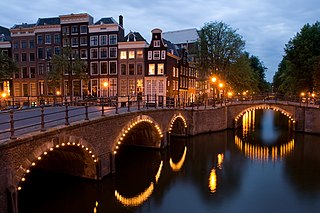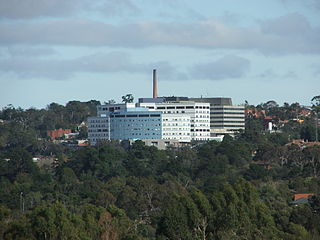Related Research Articles

Amsterdam is the capital and most populous city of the Netherlands; with a population of 907,976 within the city proper, 1,558,755 in the urban area and 2,480,394 in the metropolitan area. Found within the Dutch province of North Holland, Amsterdam is colloquially referred to as the "Venice of the North", due to the large number of canals which form a UNESCO World Heritage Site.

Illinois Institute of Technology is a private research university in Chicago, Illinois. Tracing its history to 1890, the present name was adopted upon the merger of the Armour Institute and Lewis Institute in 1940. The university has programs in architecture, business, communications, design, engineering, industrial technology, information technology, law, psychology, and science. It is classified among "R2: Doctoral Universities – High research activity".

RMIT University, officially the Royal Melbourne Institute of Technology, is a public research university in Melbourne, Australia.

3D printing or additive manufacturing is the construction of a three-dimensional object from a CAD model or a digital 3D model. It can be done in a variety of processes in which material is deposited, joined or solidified under computer control, with material being added together, typically layer by layer.

The Austin Hospital is a public teaching hospital in Melbourne's north-eastern suburb of Heidelberg, and is administered by Austin Health, along with the Heidelberg Repatriation Hospital and the Royal Talbot Rehabilitation Centre.

Amsterdam Centraal Station is the largest railway station in Amsterdam, North Holland, the Netherlands. A major international railway hub, it is used by 192,000 passengers a day, making it the second busiest railway station in the country after Utrecht Centraal and the most visited Rijksmonument of the Netherlands.

Architectural Record is a US-based monthly magazine dedicated to architecture and interior design. "The Record," as it is sometimes colloquially referred to, is widely-recognized as an important historical record of the unfolding debates in architectural practice, history and criticism in the 20th-century United States. The magazine is currently published by BNP Media. Throughout its 125 years in print, Architectural Record has engaged readership among architecture, engineering, and design professionals through articles showcasing noteworthy architectural project around the world. News, commentary, criticism, and continuing-education sections outline the scope of content. Of note are the glossy, high-quality photos of featured projects, which makes the magazine wider readership outside of just those working in the design professions.

Rapid prototyping is a group of techniques used to quickly fabricate a scale model of a physical part or assembly using three-dimensional computer aided design (CAD) data. Construction of the part or assembly is usually done using 3D printing or "additive layer manufacturing" technology.
Mecanoo is an architecture firm based in Delft, Netherlands. Mecanoo was founded in 1984 by Francine Houben, Henk Döll, Roelf Steenhuis, Erick van Egeraat and Chris de Weijer.

The Westerpark is a public urban park in Amsterdam, Netherlands. The former borough (stadsdeel) of Westerpark is named after the park, as is the current neighborhood.
Wiel Arets is a Dutch architect, architectural theorist, urbanist, industrial designer and the former Dean of the College of Architecture at the Illinois Institute of Technology in Chicago, in the United States of America. Arets was previously the 'Professor of Building Planning and Design' at the Berlin University of the Arts (UdK), Germany, and studied at the Technical University of Eindhoven, graduating in 1983. The same year later he founded Wiel Arets Architects, a multidisciplinary architecture and design studio, today with studios in Amsterdam, Maastricht, Munich, and Zürich. From 1995-2002 he was the Dean of the Berlage Institute in Rotterdam, where he introduced the idea of 'progressive-research' and co-founded the school's architectural journal named HUNCH.

The Grachtengordel is a neighborhood in Amsterdam, Netherlands located in the Centrum district. The seventeenth-century canals of Amsterdam, located in the center of Amsterdam, were added to the UNESCO World Heritage List in August 2010. The Amsterdam Canal District consists of the area around the city's four main canals: the Singel, the Herengracht, the Keizersgracht, and the Prinsengracht. From the Brouwersgracht, the canals are generally parallel with one another, leading gradually southeast into the Amstel river.

Neri Oxman is an American–Israeli designer and professor at the MIT Media Lab, where she led the Mediated Matter research group. She is known for art and architecture that combine design, biology, computing, and materials engineering.

In 3D computer graphics, 3D modeling is the process of developing a mathematical coordinate-based representation of any surface of an object in three dimensions via specialized software by manipulating edges, vertices, and polygons in a simulated 3D space.
Construction 3D Printing (c3Dp) or 3D construction Printing (3DCP) refers to various technologies that use 3D printing as a core method to fabricate buildings or construction components. Alternative terms for this process include "additive construction." "3D Concrete" refers to concrete extrusion technologies whereas Autonomous Robotic Construction System (ARCS), large-scale additive manufacturing (LSAM), or freeform construction (FC) refer to other sub-groups.

Tonny Zwollo is a Dutch architect who has worked since 1964 in the Americas. In addition to designing and building over 35 schools in Mexico, she designed the largest indigenous market in South America, in Otavalo, Ecuador. Her approach to architecture is to build what is useful for the local community. Besides schools, she has built a hotel, tourist villages and a swimming pool to boost employment of residents in Oaxaca, Mexico.

In recent years, 3D printing has developed significantly and can now perform crucial roles in many applications, with the most common applications being manufacturing, medicine, architecture, custom art and design, and can vary from fully functional to purely aesthetic applications.
Beaver Street is a street in the Financial District of Lower Manhattan in New York City. Beaver Street runs five blocks from Pearl Street in the east to Broadway in the west. Along its length, it crosses Hanover, William, Broad, and New Streets. The street is preserved as part of the New Amsterdam street grid, a New York City designated landmark.

The Tecla house is a prototype 3D-printed eco residential building made out of clay. The first model was designed by the Italian architecture studio Mario Cucinella Architects (MCA) and engineered and built by Italian 3D printing specialists WASP by April 2021, becoming the world's first house 3D-printed entirely from a mixture made from mainly local earth and water. Its name is a portmanteau of "technology" and "clay" and that of one of Italo Calvino's Invisible Cities whose construction never ceases.

3D concrete printing, sometimes called simply concrete printing, refers to digital fabrication processes for cementitious materials based on one of several different 3D printing technologies. These processes have applications in the construction industry, for the production of building blocks, building elements, civil infrastructure, or street furniture.
References
- ↑ "First 3D Printed House to Be Built In Amsterdam". ArchDaily. Retrieved 22 August 2015.
- ↑ "OPP.Today - How 3D printing by robots is set to transform building". OPP.Today. Archived from the original on 25 August 2018. Retrieved 22 August 2015. 25 August 2018
- ↑ "The printed house, coming soon: Futurists see 3-D technology radically changing the way houses are built". The Globe and Mail. Retrieved 22 August 2015.
- ↑ "3D Print Canal House". iamsterdam.com. Archived from the original on 13 March 2015. Retrieved 22 August 2015. 13 March 2015